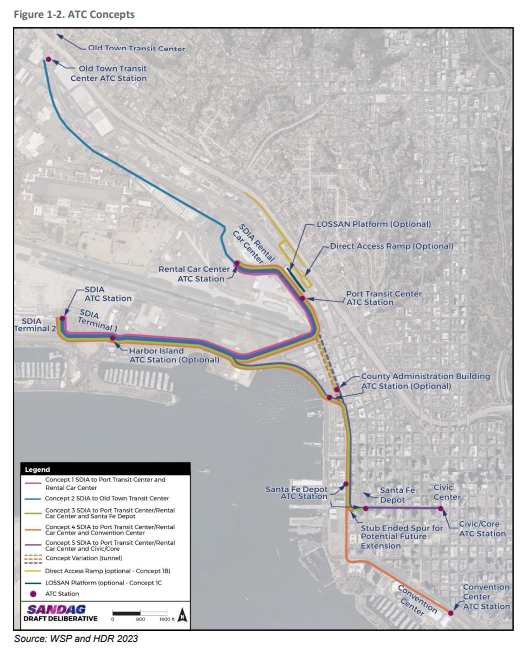San Diego airport transit link returns to data phase, pushing back next steps

SAN DIEGO (FOX 5/KUSI) — Next steps for the long-discussed San Diego International Airport transit connection could be at least three years away after federal officials advised the county’s regional planning agency to reassess the project’s route options based on updated, post-pandemic data.
The region’s elected leaders were informed of the change to the project’s timeline on Friday when staff for the agency give an update on the project during the San Diego Association of Governments’ Board of Directors meeting.
According to SANDAG staff, the schedule was amended based on conversations with the Federal Transit Administration who advised them to par down their options using more recent ridership and travel behavior data before heading into the environmental review process.
“When we took a look at that timeline, it became clear that was was additional work that needed to be done in order to meet state and federal requirement, and to allow you all the opportunity to pick what we would consider the locally-preferred alternative that would go into the environmental process,” SANDAG CEO Coleen Clementson said during the meeting.
Half-cent sales tax measure qualifies for San Diego County ballot
A previous multi-year study, which was initiated in 2019 and presented to the board last year, of about over a dozen routes for three types of direct travel from to and from the airport concluded an aerial people mover was the best and “financially feasible” option.
However, SANDAG staff said this analysis was based on growth forecasts from 2018, before the pandemic hit. More recent data, they said, would make the project more competitive when applying for funding.
Staff also added that the current number of concepts for what the transit connection could look like would make it unlikely that they could finish an environmental analysis in the federally-mandated 24-month time frame.
Returning to the data-collection process to narrow down options before initiating the environmental review would be the most time and cost efficient way to do that, according to SANDAG staff.
“By (paring) down some of those alternatives, looking at the alternatives with new data, doing new analysis, we’re saving time ultimately overall with the project schedule,” said Antoinette Meier, SANDAG senior director of regional planning.
Under the updated timeline, technical studies for the environmental review will begin in the fall of 2025 with the goal of having a draft report by the end of 2027. An outline of the timeline can be viewed below.
Chula Vista leaders debate over toll roads, Harborside Park
Although, several officials raised concern about new schedule during the board’s discussion, particularly given a prediction by SANDAG’s former CEO Hasan Ikhrata during a 2022 board meeting that construction on the transit link could begin in two years.
“It seems frustrating, to say the least,” Solana Beach Councilmember David Zito said, “that this was seemingly a very high-priority project when Hasan first came aboard and it doesn’t seem like it’s gone very far, even though one of the reasons is things have changed a lot.”
Some also questioned that the change would help reduce costs for the project in the long run, as it could cause the county to forgo significant funding opportunities that are set to close in the next few years.
“Small delays to get the analysis right are reasonable, particularly when funding partners like the FTA say they want it, but really on its face this is a multi-year delay that puts us at great risk of funding expiring,” San Diego City Councilmember Raul Campillo said on Friday.
He specifically pointed to dollars from airlines at the airport and the federal government through the Bipartisan Infrastructure Law as among those the county could miss out on given the updated timeline. Inflation, he added, could also make the project a more costly endeavor.
“Staff says the delay was intended to reduce the alternatives in the EIR and increase the competitiveness for state and federal dollars,” Campillo said. “But my read of the staff report is that this potential benefit of this delay could be significantly outweighed by near certain disadvantages of the delay.”
SANDAG staff addressed these concerns in the meeting, saying they they do not view the change as a delay but a “different approach” to streamline the arduous environmental review by parring down the number of technical studies the planning agency would have to conduct.
They also reiterated that the transit connection remains a top priority project for the agency.
Pedestrian toll lanes in the works at San Ysidro border crossing
“We want the process to be shorter, (but) we want to also make sure that we are following all the rules so that we really have a fundable project at the end of the day,” Clementson said. She added the agency already has taken steps to expedite the process such as using in-house personnel instead of consultants and combining the federal and state environmental processes.
“I just want you to know that you have the commitment of this team,” Clementson said. “We want this done and we think this is the most effective way to do it.”
Where there did appear to be some consensus was this renewed urgency to move the project along. Clementson said she hopes to bring status updates to the board more frequently in the coming months.
“I would encourage us to bring this back as soon as we can from the perspective of narrowing options,” Councilmember Zito said.
For the latest news, weather, sports, and streaming video, head to FOX 5 San Diego & KUSI News.



